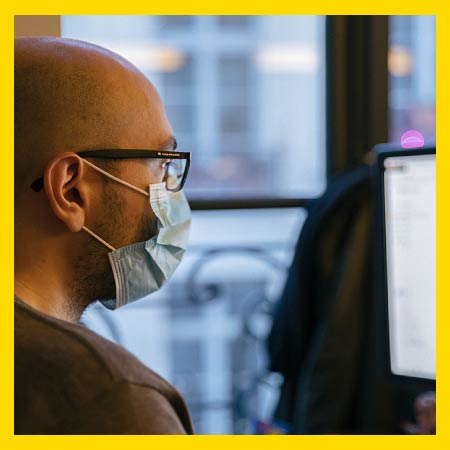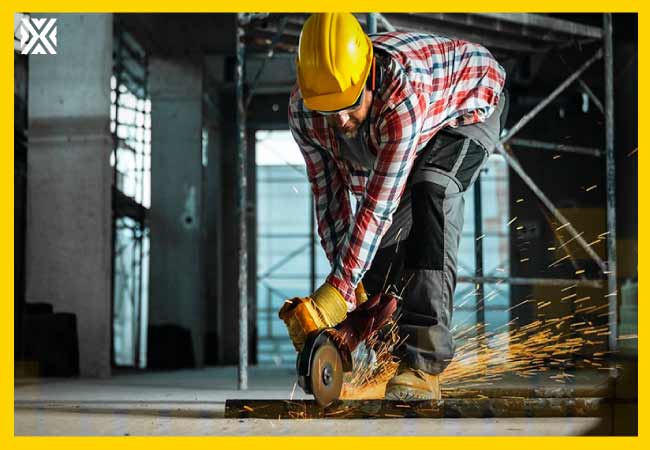Currency
July 26, 2020

For our returning US workforce, recognizing employees’ personal comfort on the job has never been more significant — especially for at-risk employees.
As the economy continues to reopen and companies across the country return to work during the ever-pressing COVID-19 pandemic, employers and employees alike are looking for more methods to deal with working in a “new normal.” For workers who require proper safety apparel — e.g. those in manufacturing, healthcare, food services, production, construction and machinery operation industries — this will include new ways to comfortably endure standing on one’s feet for long periods of time, while still practicing safe social distancing.

For employees who have returned or are soon returning to work, health concerns are especially high for those who fall into the older age brackets or are immunocompromised. According to a Kaiser Family Foundation analysis, about 41 million Americans ages 18 to 64 are at risk for serious complications from COVID-19 due to underlying conditions such as diabetes, uncontrolled asthma and heart disease. Also, on the high-risk list are Americans ages 65 and older – who currently represent the highest percentage of COVID-19 related deaths, and make up about 10.4 million people in the US workforce.
During the pandemic, the manufacturing and labour industry has unfortunately seen a growing number of COVID-19 cases erupting across various states, in particular outbreaks in facilities like meat packing plants and fulfillment centers. As businesses continue to reopen, the Centers for Disease Control and Prevention (CDC) still maintains strict guidelines for workers to “stay at least 6 feet (about 2 arms’ length) from other people” and wearing personal protective equipment (PPE) whenever possible, in order to limit the spread of COVID-19.
OSHA implores that businesses should “develop an infectious disease preparedness and response plan that can help guide protective actions against COVID-19,” and for industries that require close in-person work, to “move or reposition workstations to create more distance” and “rearrange seating in common break areas to maintain physical distance between workers.”
Foot comfort and protection are always top of mind for the companies across the manufacturing, construction and warehousing-based industries. But as the workforce returns with CDC and OSHA safety guidelines in place, extra attention must be given to immunocompromised and senior employees, who may have a significant increased risk of contracting the virus on the job. Considering the millions of Americans who’ve been laid off or furloughed as a result of COVID-19, this also means that many vulnerable members of the aging population who’ve returned to work (or plan to do so soon) are doing so out of sheer monetary necessity.
Moreover, for this industry, the typical safety practices like standing on rubber floor mats that ease fatigue — which were previously standard practice across various facilities — are no longer relevant to immunocompromised employees who may fear standing too close to each other. An alternative solution is the shoe/boot insole.
Although far from new to the manufacturing industry, during the COVID-19 pandemic, the request for insoles as PPE has substantially increased by frontline healthcare and essential workers who are prone to standing for long periods of time. A properly cushioned heel and arch support insole should keep employees feeling comfortable all day, reduce pain, and overall offer more flexibility on and off site.
This type of foot comfort is imperative to keep the aging workforce moving. Without ergonomically efficient foot support, foot pain and fatigue can have lasting effects on the body and create harmful musculoskeletal disorders (MSDs) — a disorder that older employees are at a particular high risk for. As feet hold humans’ entire bodyweight, damage done to the foot on the job can leave permanent lifelong impacts.
As the economy reopens, finding the right foot-safety support for immunocompromised and senior employees is based on both lasting comfort, as well as their personal freedom to safely socially distance at work.
A recent study from SmartAsset showed that 45 percent of respondents ages 55-64 have had their retirement planning negatively impacted due to COVID-19. With no clear end date yet for the pandemic, many working Americans — who are working past age 65 at a larger rate than ever — have had to further push out their retirement plans in effort to make up lost finances from the pandemic. With a quickly aging workforce, it’s imperative that employers keep a close eye on the health and safety standards of their more vulnerable employees now more than ever, making sure that they have the tools to succeed comfortably on the job.
As the economy continues to reopen and companies across the country return to work during the ever-pressing COVID-19 pandemic, employers and employees alike are looking for more methods to deal with working in a “new normal.” For workers who require proper safety apparel — e.g. those in manufacturing, healthcare, food services, production, construction and machinery operation industries — this will include new ways to comfortably endure standing on one’s feet for long periods of time, while still practicing safe social distancing.

Health concerns
For employees who have returned or are soon returning to work, health concerns are especially high for those who fall into the older age brackets or are immunocompromised. According to a Kaiser Family Foundation analysis, about 41 million Americans ages 18 to 64 are at risk for serious complications from COVID-19 due to underlying conditions such as diabetes, uncontrolled asthma and heart disease. Also, on the high-risk list are Americans ages 65 and older – who currently represent the highest percentage of COVID-19 related deaths, and make up about 10.4 million people in the US workforce.
During the pandemic, the manufacturing and labour industry has unfortunately seen a growing number of COVID-19 cases erupting across various states, in particular outbreaks in facilities like meat packing plants and fulfillment centers. As businesses continue to reopen, the Centers for Disease Control and Prevention (CDC) still maintains strict guidelines for workers to “stay at least 6 feet (about 2 arms’ length) from other people” and wearing personal protective equipment (PPE) whenever possible, in order to limit the spread of COVID-19.
OSHA implores that businesses should “develop an infectious disease preparedness and response plan that can help guide protective actions against COVID-19,” and for industries that require close in-person work, to “move or reposition workstations to create more distance” and “rearrange seating in common break areas to maintain physical distance between workers.”
Workers’ comfort
Foot comfort and protection are always top of mind for the companies across the manufacturing, construction and warehousing-based industries. But as the workforce returns with CDC and OSHA safety guidelines in place, extra attention must be given to immunocompromised and senior employees, who may have a significant increased risk of contracting the virus on the job. Considering the millions of Americans who’ve been laid off or furloughed as a result of COVID-19, this also means that many vulnerable members of the aging population who’ve returned to work (or plan to do so soon) are doing so out of sheer monetary necessity.
Moreover, for this industry, the typical safety practices like standing on rubber floor mats that ease fatigue — which were previously standard practice across various facilities — are no longer relevant to immunocompromised employees who may fear standing too close to each other. An alternative solution is the shoe/boot insole.
Although far from new to the manufacturing industry, during the COVID-19 pandemic, the request for insoles as PPE has substantially increased by frontline healthcare and essential workers who are prone to standing for long periods of time. A properly cushioned heel and arch support insole should keep employees feeling comfortable all day, reduce pain, and overall offer more flexibility on and off site.
This type of foot comfort is imperative to keep the aging workforce moving. Without ergonomically efficient foot support, foot pain and fatigue can have lasting effects on the body and create harmful musculoskeletal disorders (MSDs) — a disorder that older employees are at a particular high risk for. As feet hold humans’ entire bodyweight, damage done to the foot on the job can leave permanent lifelong impacts.
Aging workforce
As the economy reopens, finding the right foot-safety support for immunocompromised and senior employees is based on both lasting comfort, as well as their personal freedom to safely socially distance at work.
A recent study from SmartAsset showed that 45 percent of respondents ages 55-64 have had their retirement planning negatively impacted due to COVID-19. With no clear end date yet for the pandemic, many working Americans — who are working past age 65 at a larger rate than ever — have had to further push out their retirement plans in effort to make up lost finances from the pandemic. With a quickly aging workforce, it’s imperative that employers keep a close eye on the health and safety standards of their more vulnerable employees now more than ever, making sure that they have the tools to succeed comfortably on the job.









